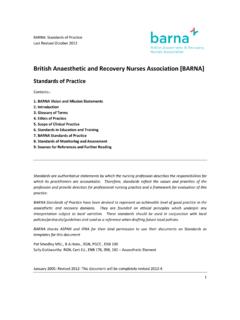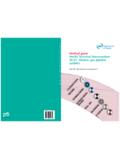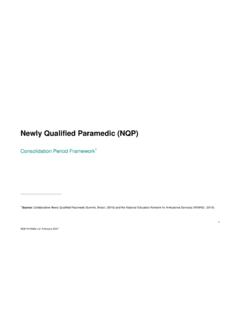Transcription of STANDARDS - woundsaustralia.com.au
1 STANDARDS . FOR. WOUND PREVENTION. AND MANAGEMENT. Third Edition Copyright Wounds Australia, 2016. STANDARDS for Wound Prevention and Management 3rd edition ISBN 978-0-9807396-9-5. Previous ISBN 978-0-9807842-0-6. Published by Cambridge Media on behalf of Wounds Australia Healing Wounds Together First edition published: 2002. Second edition published: 2010. All rights reserved Suggested citation: Wounds Australia. STANDARDS for Wound Prevention and Management. 3rd edition. Cambridge Media: Osborne Park, WA; 2016. Disclaimer: The STANDARDS were developed by Wounds Australia. They represent the best available evidence at the time of publication related to wound prevention and management.
2 The STANDARDS reflect appropriate clinical practice, to be implemented by qualified health care professionals subject to their clinical judgment of each individual case and in consideration of the individual's personal preferences and local policies. The STANDARDS should be implemented in a culturally aware and respectful manner in accordance with the principles of protection, participation and partnership. Printed copies of STANDARDS for Wound Prevention and Management (3rd edition) can be ordered from Wounds Australia: Introduction Preface Wounds Australia is an interdisciplinary professional association for individuals with an interest in wound prevention and management.
3 The objectives of Wounds Australia are to raise awareness of the science and art of wound prevention and management, and to promote evidence based wound management practices . The STANDARDS for Wound Prevention and Management presented in this revised third edition provide a framework for promoting best practice in wound prevention and management as they reflect current evidence. The STANDARDS are a valuable tool for guiding clinical practice and the development of policies, procedures and education programs. The aim of the STANDARDS is to facilitate quality care outcomes for individuals with wounds or at risk of wounding It is the ongoing vision of Wounds Australia that these STANDARDS will continue to be adopted by health care professionals, health care workers, educators and service providers across Australia, and that the challenge associated with validating and embedding the STANDARDS across all practice and educational settings be taken up enthusiastically.
4 Acknowledgement The third edition of the STANDARDS for Wound Prevention and Management has been revised by the STANDARDS Subcommittee in consultation with Wounds Australia. An expression of appreciation is extended to the STANDARDS Subcommittee: Professor Keryln Carville, PhD, STN(Cred), RN, MRCNA, FAWMA. Juliet Scott, MN(NP), B App Sc (Primary Health), Grad Dip DN, Dip of Derm, RN. Associate Professor Emily Haesler, PhD, BN, P Grad Dip Adv Nurs(Gerontics). The third edition builds on the work completed for the first and second editions of the STANDARDS . Appreciation and recognition is extended to previous subcommittee members for their contributions to the development of the 2002 and 2010 editions, which informed the third edition.
5 The contributions of Australian individuals, peak bodies and organisations who responded to the invitation to review the draft third edition of the STANDARDS is acknowledged with gratitude. STANDARDS for Wound Prevention and Management 1. Introduction CONTENTS. 1. Acknowledgements .. 1. 3. STANDARD 1: Scope of 4. STANDARD 2: Collaborative 8. STANDARD 3: Clinical Decision Making: 14. STANDARD 4: Clinical Decision Making: Planning and 25. STANDARD 5: 39. STANDARD 6: 44. STANDARD 7: Corporate 48. Glossary of 52. 2 STANDARDS for Wound Prevention and Management Introduction INTRODUCTION. STANDARDS of care play a role in identifying expected levels of care that should be delivered to individual's receiving wound prevention and management.
6 STANDARDS contribute to ensuring that care delivery is of a consistent high level and that unwarranted variation is reduced. STANDARDS play a role in improving safety of the individual and promoting positive outcomes of care (for example, and reducing avoidable wounds and promoting wound healing). The STANDARDS presented in this document are intended for use by individual health care professionals and health care workers for monitoring their own care delivery STANDARDS and identifying areas for professional development. They may also be used by health care services to develop policies and procedures, design education programs, audit clinical care and undertake staff appraisal.
7 The STANDARDS may be used by individuals receiving care and their informal carers to identify the standard of care that they can expect when receiving wound prevention and management. The STANDARDS should be used in conjunction with other clinical care STANDARDS , accreditation STANDARDS and professional STANDARDS . There are seven core STANDARDS in the third edition of STANDARDS for Wound Prevention and Management. The STANDARDS address key components of wound prevention and management, including the scope under which health care professionals and health care workers practice, working in collaboration, clinical decision making (two STANDARDS that focus on assessment, planning and practice), documentation, education and corporate governance.
8 Each Standard outlines an expected level of care and includes a rationale and evidence criteria that demonstrate that the standard has been reached. A background and context is included as extended information. The STANDARDS presented in this third edition build on those in previous editions. A targeted literature search was undertaken in medical databases, legislature databases and Google Scholar to identify relevant references published since the previous edition in 2008. Relevant key documents were reviewed from other organisations ( Australia Health Practitioner Regulation Agency and Australian Commission on Safety and Quality in Health Care) and relevant evidence-based clinical guidelines were reviewed.
9 The references included in the previous editions were also reviewed for their ongoing relevance to current practice. The third edition of STANDARDS for Wound Prevention and Management underwent an extensive stakeholder review that was advertised on the Wounds Australia website. Over 30 key organisations ( professional bodies, educational organisation and peak bodies) were also invited to review the STANDARDS . All feedback was reviewed by the development team and incorporated into the STANDARDS for Wound Prevention and Management as appropriate. STANDARDS for Wound Prevention and Management 3. Standard 1. STANDARD 1. SCOPE OF PRACTICE. Safety and wound healing potential of the individual is enhanced by practice that respects and complies with legislation, regulations, scope of practice, service provider policies, current evidence and ethics.
10 Rationale Practising within the legal boundaries of scope of practice and complying with legislation and regulations is a requirement of professional practice. Implementing wound prevention and management that reflects current best practice is associated with positive outcomes. Criteria Scope of practice includes: Performance in accordance with legislation, regulations, scope of practice and service provider Evidence Criteria Function in accordance with the scope of practice as determined by regulatory authorities. Accountability for practice. Awareness of limitations of scope of practice for regulated and non- regulated practice. Knowledge of, and compliance with, policies and procedures of relevant service providers.









